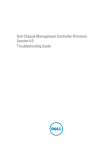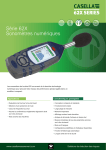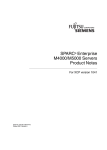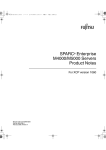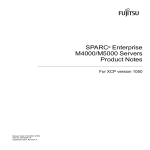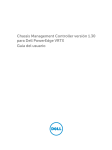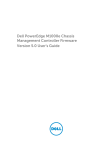Download Dell Chassis Management Controller Version 4.50 White Paper
Transcript
Dell Power Edge M1000e Chassis Management Controller Version 4.5 - Extended Power Performance Using 3000W AC PSU This technical brief highlights the Extended Power Performance using 3000W AC PSU in CMC 4.5 Dell Engineering January 2014 Author(s) Sunil Vyas Ashish Munjal Michael Hobbs Tracy Smith A Dell Technical White Paper Revisions Date Description January 2014 Initial Release THIS WHITE PAPER IS FOR INFORMATIONAL PURPOSES ONLY, AND MAY CONTAIN TYPOGRAPHICAL ERRORS AND TECHNICAL INACCURACIES. THE CONTENT IS PROVIDED AS IS, WITHOUT EXPRESS OR IMPLIED WARRANTIES OF ANY KIND. © 2013 Dell Inc. All rights reserved. Reproduction of this material in any manner whatsoever without the express written permission of Dell Inc. is strictly forbidden. For more information, contact Dell. PRODUCT WARRANTIES APPLICABLE TO THE DELL PRODUCTS DESCRIBED IN THIS DOCUMENT MAY BE FOUND AT: http://www.dell.com/learn/us/en/19/terms- of- sale- commercial- and- public- sector Performance of network reference architectures discussed in this document may vary with differing deployment conditions, network loads, and the like. Third party products may be included in reference architectures for the convenience of the reader. Inclusion of such third party products does not necessarily constitute Dell’s recommendation of those products. Please consult your Dell representative for additional information. Trademarks used in this text: Dell™, the Dell logo, Dell Boomi™, Dell Precision™ ,OptiPlex™, Latitude™, PowerEdge™, PowerVault™, PowerConnect™, OpenManage™, EqualLogic™, Compellent™, KACE™, FlexAddress™, Force10™ and Vostro™ are trademarks of Dell Inc. Other Dell trademarks may be used in this document. Cisco Nexus®, Cisco MDS®, Cisco NX0S®, and other Cisco Catalyst® are registered trademarks of Cisco System Inc. EMC VNX®, and EMC Unisphere® are registered trademarks of EMC Corporation. Intel®, Pentium®, Xeon®, Core® and Celeron® are registered trademarks of Intel Corporation in the U.S. and other countries. AMD® is a registered trademark and AMD Opteron™, AMD Phenom™ and AMD Sempron™ are trademarks of Advanced Micro Devices, Inc. Microsoft®, Windows®, Windows Server®, Internet Explorer®, MS- DOS®, Windows Vista® and Active Directory® are either trademarks or registered trademarks of Microsoft Corporation in the United States and/or other countries. Red Hat® and Red Hat® Enterprise Linux® are registered trademarks of Red Hat, Inc. in the United States and/or other countries. Novell® and SUSE® are registered trademarks of Novell Inc. in the United States and other countries. Oracle® is a registered trademark of Oracle Corporation and/or its affiliates. Citrix®, Xen®, XenServer® and XenMotion® are either registered trademarks or 2 Dell Power Edge M1000e Chassis Management Controller Version 4.5 - Extended Power Performance Using 3000W AC PSU trademarks of Citrix Systems, Inc. in the United States and/or other countries. VMware®, Virtual SMP®, vMotion®, vCenter® and vSphere® are registered trademarks or trademarks of VMware, Inc. in the United States or other countries. IBM® is a registered trademark of International Business Machines Corporation. Broadcom® and NetXtreme® are registered trademarks of Broadcom Corporation. Qlogic is a registered trademark of QLogic Corporation. Other trademarks and trade names may be used in this document to refer to either the entities claiming the marks and/or names or their products and are the property of their respective owners. Dell disclaims proprietary interest in the marks and names of others. 3 Dell Power Edge M1000e Chassis Management Controller Version 4.5 - Extended Power Performance Using 3000W AC PSU Table of contents Revisions ..................................................................................................................................................................................................2 1 2 Introduction ..................................................................................................................................................................................... 5 1.1 What is Extended Power Performance ........................................................................................................................... 5 1.2 Why EPP - Extended Power Performance on 3000W PSUs ..................................................................................... 5 Managing EPP features on CMC interfaces ............................................................................................................................. 8 2.1 Managing EPP feature using the Web Interface: ......................................................................................................... 8 2.1.1 EPP Configuration and Control ....................................................................................................................................... 8 2.1.2 EPP Feature Status ............................................................................................................................................................. 9 2.1.3 EPP Power Monitoring and Statistics ........................................................................................................................... 10 2.1.4 EPP Error Reporting .......................................................................................................................................................... 13 2.2 Managing EPP feature using RACADM interface:.......................................................................................................14 2.2.1 EPP Configuration and Control ......................................................................................................................................14 2.2.2 EPP Status Verification .....................................................................................................................................................14 2.2.3 EPP Feature Status ............................................................................................................................................................ 15 2.2.4 EPP Error Reporting .......................................................................................................................................................... 15 2.2.5 EPP Log Messages and RAC Log ...................................................................................................................................16 3 EPP with Other Power Configurations: ................................................................................................................................... 17 3.1 EPP and Server Performance Over Power Redundancy (SPOPR) .......................................................................... 17 3.2 EPP and Allow 110 VAC Operation ................................................................................................................................ 17 3.2.1 EPP and Server Based Power Management (SBPM) .................................................................................................. 17 4 4 3.3 EPP and Dynamic Power Supply Engagement (DPSE) .............................................................................................. 17 3.4 EPP and Max Power Conservation Mode (MPCM) ..................................................................................................... 17 3.5 EPP and Redundancy Policy .......................................................................................................................................... 18 3.6 EPP and System Input Power Cap .................................................................................................................................19 EPP Feature Constraints ............................................................................................................................................................ 20 Dell Power Edge M1000e Chassis Management Controller Version 4.5 - Extended Power Performance Using 3000W AC PSU 1 Introduction This whitepaper provides an overview of the Extended Power Performance (EPP) feature enabled on 3000W AC Power Supplies. 1.1 What is Extended Power Performance The Extended Power Performance (EPP) feature is a new feature released in Chassis Management Controller (CMC) Version 4.5, which allows increased power allocations in the PowerEdge M1000e modular chassis to support high- end servers. This feature enables the power allocated to exceed the redundant power capability of the Grid Redundant power supply configuration by up to 30% with all six 3000W AC power supplies. 1.2 Why EPP - Extended Power Performance on 3000W PSUs Prior to CMC 4.5, the highest rated Power Supply Unit (PSU) supported in the M1000e chassis is the 2700W PSU. When customers select the Grid Redundancy policy, the M1000e chassis can have up to 7602W of DC power for the servers and infrastructure. Due to power constraints, manufacturing is unable to ship M1000e chassis configurations of more than 16 M420 servers, or more than 7 M910 server configurations to the customer. The redundant power demands of the full configuration of current generation of servers have far exceeded the redundant power capabilities of the M1000e modular power subsystem. The new 3000W AC PSUs provides a solution to customers to support their high- end server configurations in the M1000e Chassis. The Extended Power Performance (EPP) feature allows power allocations by up to 130% when the Power subsystem is configured for Grid redundancy mode. The EPP feature is applicable only when there are 6 power supply units, all power supply units are 3000W AC, and Redundancy Policy is set to Grid Redundancy. 5 Dell Power Edge M1000e Chassis Management Controller Version 4.5 - Extended Power Performance Using 3000W AC PSU Figure 1 EPP Feature adds 30% Virtual Power in Six PSU Configuration (Extended Power Performance Enabled) EPP feature shall not allow any additional servers to power up compared to a configuration without EPP enabled on the 3000W AC power supply configuration. The additional power gained by upgrading power supplies from 2360W, or 2700W, to 3000W is available to power on additional servers. The additional EPP power pool is available only to increase the performance of the existing servers. Figure 2 EPP – Two levels of power gain, illustrates two levels of power gain. The first level of power gain of 1038W is from the aggregate capacity gain from moving from three 2700W PSUs to three 3000W PSUs. This first level of power gain is available for powering on additional servers. The second level is a power gain of 2700W increasing the power gain for server performance by 30%. The two levels when combined give a total power gain of 3738W (1038W + 2700W) in GRID redundancy. 6 Dell Power Edge M1000e Chassis Management Controller Version 4.5 - Extended Power Performance Using 3000W AC PSU Figure 2 7 EPP – Two levels of power gain Dell Power Edge M1000e Chassis Management Controller Version 4.5 - Extended Power Performance Using 3000W AC PSU 2 Managing EPP features on CMC interfaces This feature can be managed through the CMC Web interface and RACADM interface. The CMC Web interface supports the EPP feature for the following: • • • • EPP"feature"control,"(Enable/Disable)"using"Chassis Power Configuration"page. EPP"Status"using"Chassis Home Page EPP"Power"Monitoring"and"Statistics EPP"status"updates"captured"in"CMC"Log CMC RACADM CLI Interface support shall be available for the following: • • • • 2.1 EPP"feature"control"(Enable/Disable)"using"racadm getconfig/config EPP"status"using"racadm getpbinfo Error"Reporting"using"racadm getpbinfo EPP"status"updates"captured"in"RAC"Log Managing EPP feature using the Web Interface: The following sections describe how to manage the EPP feature on the CMC Web Interface. 2.1.1 EPP Configuration and Control The Power Configuration page on the Web interface allows a user to enable or disable the EPP feature using the check box. Configurations consisting of six 3000W AC PSUs are shipped from the factory with the EPP feature enabled, as factory default. 8 Dell Power Edge M1000e Chassis Management Controller Version 4.5 - Extended Power Performance Using 3000W AC PSU Figure 3 2.1.2 EPP feature control EPP Feature Status The Chassis Health page on the Web interface allows you to view the EPP status. The Power section displays one of the following status states: • • • • 9 Disabled Enabled"(active) Enabled"(inactive) Enabled"(unsupported) Dell Power Edge M1000e Chassis Management Controller Version 4.5 - Extended Power Performance Using 3000W AC PSU Figure 4 2.1.3 EPP feature status on Chassis Health page EPP Power Monitoring and Statistics The Power Monitoring page on the Web interface allows you to monitor the EPP feature statistics. The following figures illustrate the statistics displayed for the various EPP status states: 10 Dell Power Edge M1000e Chassis Management Controller Version 4.5 - Extended Power Performance Using 3000W AC PSU EPP Disabled: Figure 5 11 EPP Disabled Status on Power Monitoring Page. Dell Power Edge M1000e Chassis Management Controller Version 4.5 - Extended Power Performance Using 3000W AC PSU EPP Enabled (active): Figure 6 EPP Enabled (active) Status on Power Monitoring Page. EPP Enabled (inactive): Figure 7 12 EPP Enabled (inactive) Status on Power Monitoring Page Dell Power Edge M1000e Chassis Management Controller Version 4.5 - Extended Power Performance Using 3000W AC PSU EPP Enabled (unsupported): Figure 8 2.1.4 EPP Enabled (unsupported) Status on Power Monitoring Page EPP Error Reporting The Power Monitoring page on the Web interface allows you to view the EPP feature errors for the unsupported EPP status states: EPP Enabled (unsupported): Figure 9 Error Message describing why EPP is unsupported EPP Enabled (unsupported – multiple reasons) Figure 10 13 Multiple unsupported reasons describing why EPP is not supported. Dell Power Edge M1000e Chassis Management Controller Version 4.5 - Extended Power Performance Using 3000W AC PSU EPP Disabled: Figure 11 When EPP is disabled. To view the EPP feature control related logs from CMC Web Interface, go to Logs and CMC logs: Figure 12 2.2 EPP Log Messages on CMC Web Interface. Managing EPP feature using RACADM interface: The following sections describe how to manage the EPP feature using the RACADM interface. 2.2.1 EPP Configuration and Control You can enable or disable the EPP feature using the RACADM interface on the chassis with 3000W AC PSU configuration using the following commands: • To"Enable"EPP: $ racadm config -g cfgChassisPower -o cfgChassisEPPEnable 1 Object value modified successfully • To"Disable"EPP:" $ racadm config -g cfgChassisPower -o cfgChassisEPPEnable 0 Object value modified successfully 2.2.2 EPP Status Verification You can verify if the EPP feature is enabled or disabled on a chassis with 3000W AC PSU configuration using the following RACADM commands:: • Execute"following"command""to"check"EPP"status: $ racadm getconfig -g cfgChassisPower -o cfgChassisEPPEnable 1 = EPP is Enabled 14 Dell Power Edge M1000e Chassis Management Controller Version 4.5 - Extended Power Performance Using 3000W AC PSU 0 = EPP is Disabled 2.2.3 EPP Feature Status To view the EPP feature status use the racadm getpbinfo command. The following are examples of the EPP status information displayed: • Example 1 $ racadm getpbinfo Extended Power Performance(EPP) Status = Enabled (inactive) Available Power in EPP Pool = 3167 W (10806 BTU/h) Used Power in EPP Pool = 0 W (0 BTU/h) EPP Percent - Available = 100.0 • Example 2 $ racadm getpbinfo 2.2.4 Extended Power Performance(EPP) Status = Enabled (active) Available Power in EPP Pool = 1698 W (5793 BTU/h) Used Power in EPP Pool = 1468 W (5009 BTU/h) EPP Percent - Available = 53.0 EPP Error Reporting To view the EPP feature related errors use the racadm getpbinfo command. The following are examples of the EPP feature related errors displayed: • Example 1 $ racadm getpbinfo Extended Power Performance(EPP) Status = Enabled (unsupported) Available Power in EPP Pool = 0 W (0 BTU/h) Used Power in EPP Pool = 0 W (0 BTU/h) EPP Percent - Available = 0.0 EPP Error Messages The feature is not supported while Max Power Conservation Mode is enabled. • Example 2 $ racadm getpbinfo 15 Dell Power Edge M1000e Chassis Management Controller Version 4.5 - Extended Power Performance Using 3000W AC PSU Extended Power Performance(EPP) Status = Enabled (unsupported) Available Power in EPP Pool = 0 W (0 BTU/h) Used Power in EPP Pool = 0 W (0 BTU/h) EPP Percent - Available = 0.0 EPP Error Messages The feature is not supported with an unsupported PSU : PSU Slot 1. The feature is not supported with an unsupported PSU : PSU Slot 2. The feature is not supported with an unsupported PSU : PSU Slot 3. The feature is not supported with an unsupported PSU : PSU Slot 4. The feature is not supported with an unsupported PSU : PSU Slot 5. The feature is not supported with an unsupported PSU : PSU Slot 6. 2.2.5 EPP Log Messages and RAC Log The EPP feature enable or disable control operations performed using the RACADM interface are captured in the RAC logs. To view the EPP feature control related logs, use the racadm getraclog command: $ racadm getraclog Jul 31 14:16:11 CMC-4C2WXF1 Log Cleared Jul 31 14:15:49 CMC-4C2WXF1 Extended Power Performance is Enabled Jul 31 14:15:49 CMC-4C2WXF1 Extended Power Performance is Disabled 16 Dell Power Edge M1000e Chassis Management Controller Version 4.5 - Extended Power Performance Using 3000W AC PSU 3 EPP with Other Power Configurations: The following sections describe each power configuration which impacts the EPP Settings: 3.1 EPP and Server Performance Over Power Redundancy (SPOPR) The two features Extended Power Performance (EPP) and Server Performance Over Power Redundancy (SPOPR) are mutually exclusive. The SPOPR feature has been available for customers since the CMC 3.1 release. CMC 4.45 and earlier versions have shipped with SPOPR Enabled as the default setting. The SPOPR setting is completely superseded by the EPP configuration setting. SPOPR is no longer supported and grayed out on the 3000W AC power supply configuration as Extended Power Performance feature is available to substitute for SPOPR. 3.2 EPP and Allow 110 VAC Operation Since the 3000W AC power supplies can only operate on 220 VAC, the 110 VAC is not supported. The “Allow 110VAC Operation” field grayed out on the CMC Web interface. The RACADM interface will block the user from setting 110 VAC value if Noble CMC has the six 3000W AC power supply configuration. 3.2.1 EPP and Server Based Power Management (SBPM) The Server Based Power Management (SBPM) feature is not compatible with EPP. The EPP feature is not supported if SBMP is enabled. 3.3 EPP and Dynamic Power Supply Engagement (DPSE) The Dynamic Power Supply Engagement (DPSE) feature is not compatible with EPP. The EPP feature is not supported if DPSE is enabled. 3.4 EPP and Max Power Conservation Mode (MPCM) Max Power Conservation Mode (MPCM) can be enabled on the 3000W AC PSU configuration, as shown below. You are prompted to Click OK to continue, with a pop up message that the feature is not supported while Extended Power Performance is enabled. Enabling MPCM brings down all server power allocations to the respective Static Lower Boundary. 17 Dell Power Edge M1000e Chassis Management Controller Version 4.5 - Extended Power Performance Using 3000W AC PSU Figure 13 3.5 Warning Message when user tries to Enabled MPCM while EPP is Enabled (active). EPP and Redundancy Policy “Power Supply Redundancy” and “No Redundancy” are not compatible with EPP. Modification of the Redundancy Policy from “Grid Redundancy” (factory shipped default setting), to “Power Supply Redundancy” or “No Redundancy” on EPP Enabled configuration is not possible. The incompatible options are grayed out on the Web interface as illustrated in Figure 12. 18 Dell Power Edge M1000e Chassis Management Controller Version 4.5 - Extended Power Performance Using 3000W AC PSU Figure 14 All three Redundancy Policy (Grid Redundancy, Power Supply Redundancy and No Redundancy) options. 3.6 EPP and System Input Power Cap Reduction of the System Input Power Cap value on an EPP Enabled configuration, to less than or equal to 13300W AC (45381 BTU/h) is not possible when EPP is enabled as it is not supported while EPP is enabled. 19 Dell Power Edge M1000e Chassis Management Controller Version 4.5 - Extended Power Performance Using 3000W AC PSU 4 EPP Feature Constraints The EPP feature does not operate if: • • • • Any"power"supply"is"reporting"loss"of"Input"Voltage. Any"power"supply"is"in"a"state"other"than"Online,"for"example"Failed"state. Any"power"supply"is"reporting"loss"of"Output"Voltage."This"occurs"if"a"power"supply"is"in"failed"state" due"to"being"unable"to"convert"AC"to"DC"power,"or"if"a"PSU""failed"to"provide"FRU"data. Power"Redundancy"Status"is"lost,"for"example"due"to"PSU"failure. The EPP feature is not supported if: • • • • • • • • • 20 The"Redundant"policy"is"set"to"PSU"Redundancy"or"No"Redundancy"power"policy. The"chassis"has"a"mixed"configuration"of"power"supplies,"or"a"configuration"with"less"than"six"3000W" AC"power"supplies. The"EPP"range"of"available"power"can"be"used"only"for"server"performance"increase,"and"not"for"server" power"on. Dynamic"Power"Supply"Engagement"is"enabled. Max"Power"Conservation"Mode"is"enabled. Server"Performance"Over"Power"Redundancy"is"enabled. Chassis"Management"Controller"Failover"is"in"progress. Chassis"Management"Controller"Firmware"update"is"in"progress. System"Input"Power"Cap"is"set"to"less"than"or"equal"to"13300"W"(45381"BTU/h). Dell Power Edge M1000e Chassis Management Controller Version 4.5 - Extended Power Performance Using 3000W AC PSU




















